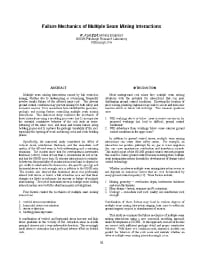Mining Publication: Failure Mechanics of Multiple Seam Mining Interactions
Original creation date: August 2005
Authors: RK Zipf
NIOSHTIC2 Number: 20028271
In: Peng SS, Mark C, Finfinger GL, Tadolini SC, Heasley KA, Khair AW, eds. Proceedings of the 24th International Conference on Ground Control in Mining, Morgantown, West Virginia, August 2-4, 2005. Morgantown, WV: West Virginia University, 2005; :93-106
Multiple-seam mining interactions caused by full-extraction mining, whether due to undermining or overmining, often involve tensile failure of the affected mine roof. The adverse ground control conditions may prevent mining for both safety and economic reasons. Prior researchers have identified the geometric, geologic, and mining factors controlling multiple-seam mining interactions. This numerical study examines the mechanics of these interactions using a modeling procedure that (1) incorporates the essential constitutive behavior of the rock, such as strain-softening of the intact rock and shear and tensile failure along bedding planes, and (2) captures the geologic variability of the rock, especially the layering of weak and strong rocks and weak bedding planes. Specifically, the numerical study considered the effect of vertical stress, interburden thickness, and the immediate roof quality of the affected seam in both undermining and overmining situations. The models show that for overburden-to-interburden thickness (OB/IB) ratios of less than 5, interactions do not occur and that for OB/IB ratios of more than 50, extreme interaction is a certainty. In between, the possibility of an interaction was found to depend on gob width-to-interburden thickness ratio, site-specific geology, and horizontal stress to rock strength ratio in addition to the OB/IB ratio. The models also showed that horizontal stress was profoundly altered well above or below a full extraction area and that these changes are likely to influence the success or failure of multiple-seam mining. The role of horizontal stress in multiple-seam mining interactions has received little attention in prior investigations. Four factors control the mechanics of multiple-seam mining interactions: (1) vertical stress concentration, (2) horizontal stress concentration, (3) stress redirection, and (4) bedding plane slip bands. A combination of vertical and horizontal stress increase and high stress gradients in the vicinity of full-extraction areas reorient principal stresses into a very unfavorable direction. This seemingly small stress reorientation has a profound adverse effect on bedded rock.

NIOSHTIC2 Number: 20028271
In: Peng SS, Mark C, Finfinger GL, Tadolini SC, Heasley KA, Khair AW, eds. Proceedings of the 24th International Conference on Ground Control in Mining, Morgantown, West Virginia, August 2-4, 2005. Morgantown, WV: West Virginia University, 2005; :93-106
- 60 Years of Rockbursting in the Coeur D'Alene District of Northern Idaho, USA: Lessons Learned and Remaining Issues
- AMSS - Analysis of Multiple Seam Stability - 2.1.02
- Analysis of Multiple Seam Stability
- Computer Simulation of Ground Behaviour and Rock Bolt Interaction at Emerald Mine
- Global Trends in Coal Mine Horizontal Stress Measurements
- Horizontal Stress and Longwall Headgate Ground Control
- Multiple Seam Longwall Mining in the U.S. - Lessons for Ground Control
- Multiple-Seam Mining in the United States: Design Based on Case Histories
- Technology News 504 - NIOSH Releases New AHSEM and ARBS Software Programs to Improve Ground Control
- Variation of Horizontal Stresses and Strains in Mines in Bedded Deposits in the Eastern and Midwestern United States